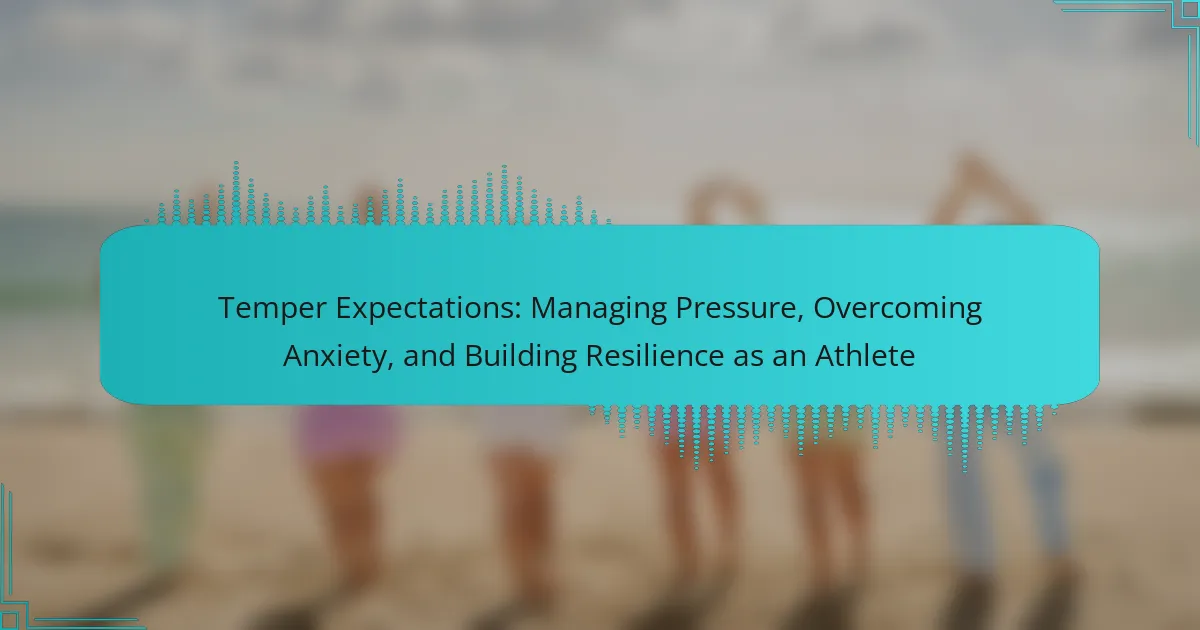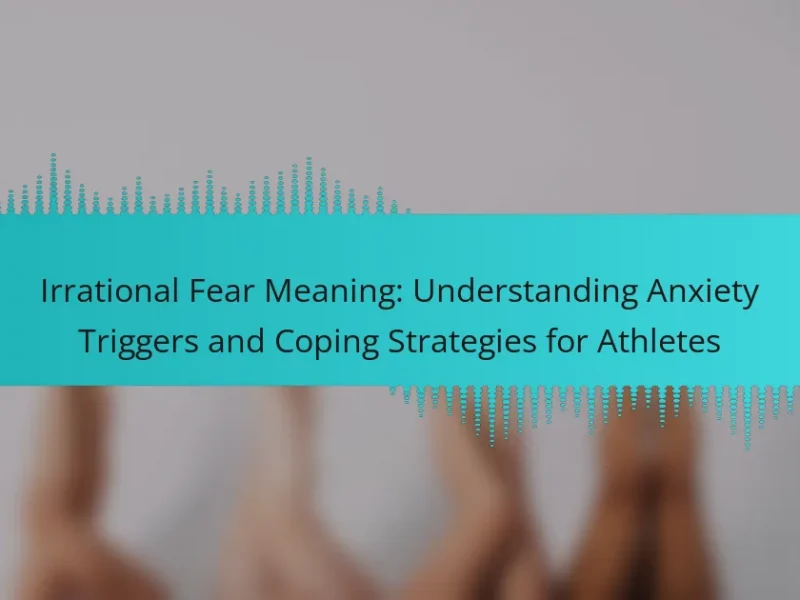Managing pressure is crucial for athletes to maintain focus and enhance performance. This article explores strategies for tempering expectations, overcoming anxiety, and building resilience. It discusses the impact of external pressures, the importance of realistic goal-setting, and effective coping techniques like mindfulness and visualization. Additionally, it highlights the role of support systems in fostering mental strength and emotional regulation.

How Can Athletes Manage Pressure Effectively?
Athletes can manage pressure effectively by tempering expectations and focusing on resilience-building strategies. Setting realistic goals reduces anxiety, allowing athletes to concentrate on performance rather than outcomes. Techniques such as mindfulness, visualization, and positive self-talk can enhance mental strength. Regular practice of these methods fosters a resilient mindset, enabling athletes to navigate high-pressure situations with confidence.
What are common sources of pressure for athletes?
Athletes face various sources of pressure that can impact their performance. Common pressures include high expectations from coaches, family, and fans, as well as personal goals and aspirations. The competitive environment itself can create anxiety, leading to a fear of failure. Additionally, media scrutiny can amplify stress, making it difficult for athletes to focus. Managing these pressures requires resilience and effective coping strategies.
What strategies can help athletes cope with performance anxiety?
Athletes can cope with performance anxiety by implementing various strategies. These include practicing mindfulness to enhance focus, setting realistic goals to temper expectations, and using visualization techniques to prepare mentally. Additionally, fostering a supportive environment with coaches and teammates can build resilience. Regular physical conditioning also helps reduce anxiety by increasing confidence in abilities.
How can visualization techniques reduce anxiety?
Visualization techniques can effectively reduce anxiety by helping athletes focus on positive outcomes and manage stress. These techniques create mental imagery that enhances performance and builds confidence. Engaging in visualization allows athletes to rehearse scenarios, reducing uncertainty and fear. As a result, athletes experience lower anxiety levels and improved resilience during competitions.
What role does goal-setting play in managing pressure?
Goal-setting plays a crucial role in managing pressure by providing clear objectives and a sense of direction. Effective goals help athletes focus on specific outcomes, reducing anxiety and enhancing performance. By setting achievable targets, athletes can build resilience and maintain motivation, even in high-pressure situations. This structured approach encourages a growth mindset, allowing athletes to view challenges as opportunities for development rather than sources of stress.
What are the signs of excessive pressure in athletes?
Excessive pressure in athletes manifests through signs such as anxiety, fatigue, and decreased performance. These symptoms indicate an overwhelming burden that can hinder their ability to compete effectively.
Athletes may experience physical signs like insomnia, headaches, or stomach issues, which are often linked to stress. Emotional signs include irritability, mood swings, and loss of motivation, reflecting their struggle to cope with expectations.
Cognitive signs can manifest as difficulty concentrating, negative self-talk, and fear of failure. Recognizing these signs early is crucial for implementing strategies to manage pressure and build resilience.
Addressing these symptoms through support systems, mental health resources, and open communication can help athletes regain control and enhance their performance.

What Are the Unique Challenges of Anxiety for Athletes?
Athletes face unique challenges with anxiety that can impact performance and mental health. Managing pressure is essential for maintaining focus and resilience.
One major challenge is the fear of failure, which can lead to performance anxiety. Athletes may experience heightened stress during competitions, affecting their decision-making and physical execution.
Another challenge is the impact of expectations from coaches, teammates, and fans. These external pressures can amplify anxiety, creating a cycle that hinders performance.
Building resilience involves developing coping strategies, such as mindfulness and visualization techniques. These methods help athletes manage anxiety and enhance their performance under pressure.
How does competition heighten anxiety levels?
Competition can significantly heighten anxiety levels in athletes. The pressure to perform can lead to heightened stress responses, impacting focus and confidence. Factors such as fear of failure, comparison to others, and high expectations contribute to this anxiety. As a result, athletes may experience physical symptoms like increased heart rate and tension, which can hinder their performance. Managing these feelings through techniques like visualization and mindfulness can help mitigate anxiety and improve resilience.
What psychological factors contribute to anxiety in sports?
Psychological factors contributing to anxiety in sports include pressure to perform, fear of failure, and perfectionism. Athletes often feel overwhelmed by expectations from themselves and others, leading to increased stress. Managing these factors is essential for building resilience and enhancing performance. Research indicates that athletes with high levels of self-efficacy experience lower anxiety, as they believe in their capabilities. Techniques such as visualization and mindfulness can also help in mitigating anxiety, allowing athletes to focus on the present moment rather than potential outcomes.
How can self-talk influence an athlete’s mindset?
Self-talk can significantly enhance an athlete’s mindset by fostering resilience and reducing anxiety. Positive self-talk encourages focus, boosts confidence, and helps manage performance pressure. Athletes can use affirmations and constructive dialogue with themselves to shift their perspective, turning negative thoughts into motivating challenges. This practice can lead to improved emotional regulation, allowing athletes to perform at their best under stress. Consistent self-talk strategies cultivate a growth mindset, ultimately enhancing overall athletic performance.
What are the impacts of social media on athlete anxiety?
Social media can significantly increase athlete anxiety by amplifying performance pressure and exposing athletes to public scrutiny. The constant comparison with peers on social platforms can lead to heightened self-doubt and stress. Research indicates that 70% of athletes report feeling pressure from social media to maintain a certain image, which can exacerbate anxiety levels. Additionally, negative comments and cyberbullying can further impact mental health, making it crucial for athletes to develop resilience strategies to manage these challenges effectively.

How Can Resilience Be Built in Athletes?
Building resilience in athletes requires a focus on managing pressure and overcoming anxiety. Strategies include setting realistic goals, developing coping techniques, and fostering a supportive environment.
Athletes should temper expectations by recognizing that setbacks are part of growth. This understanding helps in reframing negative thoughts and maintaining motivation. Practicing mindfulness can enhance emotional regulation, allowing athletes to stay present during competitions.
Creating a routine that includes mental preparation is vital. Visualization techniques can help athletes mentally rehearse scenarios, reducing anxiety and boosting confidence. Regularly engaging in stress-relief activities contributes to overall mental health.
Support systems play a crucial role in resilience. Coaches, teammates, and family can provide encouragement and constructive feedback, helping athletes navigate challenges. Building strong relationships within the sport fosters a sense of belonging, which is essential for resilience.
What are the key characteristics of resilient athletes?
Resilient athletes exhibit key characteristics that enable them to manage pressure and overcome anxiety. They possess mental toughness, adaptability, and a strong sense of purpose. Mental toughness allows them to maintain focus under stress. Adaptability helps them adjust strategies in response to challenges. A strong sense of purpose motivates them to persist despite setbacks. These traits collectively enhance their resilience, enabling them to thrive in competitive environments.
How can athletes develop a growth mindset?
Athletes can develop a growth mindset by embracing challenges, learning from feedback, and maintaining perseverance. This mindset fosters resilience against pressure and anxiety. Setting realistic goals helps manage expectations and reduces stress. Engaging in reflective practices, such as journaling, enhances self-awareness and promotes continuous improvement. Surrounding oneself with supportive teammates and coaches further reinforces positive thinking and growth.
What role does feedback play in building resilience?
Feedback is essential for building resilience as it provides athletes with insights to improve performance. Constructive feedback helps identify strengths and weaknesses, fostering a growth mindset. This process encourages athletes to adapt and learn from challenges, ultimately enhancing their ability to cope with pressure and anxiety. Regular feedback loops create a supportive environment, reinforcing persistence and determination. As a result, athletes become more resilient, better equipped to face adversity.
What techniques can athletes use to bounce back from setbacks?
Athletes can employ techniques like reframing setbacks, setting realistic goals, and practicing mindfulness to bounce back effectively. Reframing helps shift perspective on failure, viewing it as a learning opportunity. Setting realistic goals reduces pressure and fosters a sense of achievement. Mindfulness techniques, such as meditation, enhance focus and reduce anxiety, contributing to resilience.

What Are the Best Practices for Coping with Stress and Anxiety?
To cope with stress and anxiety effectively, athletes should temper expectations, manage pressure, and build resilience. Setting realistic goals helps reduce performance anxiety. Practicing mindfulness techniques, such as meditation or deep breathing, can enhance focus and calmness. Regular physical activity not only improves physical health but also releases endorphins, which alleviate stress. Establishing a support network of coaches and teammates fosters a sense of belonging, further mitigating anxiety. Lastly, maintaining a balanced lifestyle with proper nutrition and sleep is crucial for overall mental well-being.
How can athletes incorporate relaxation techniques into their routine?
Athletes can incorporate relaxation techniques by scheduling regular sessions, practicing mindfulness, and utilizing breathing exercises. These methods help manage pressure, reduce anxiety, and enhance resilience. For example, progressive muscle relaxation can lower stress levels and improve focus during competitions. Additionally, yoga can promote physical and mental well-being, fostering a balanced approach to training.
What role does physical fitness play in stress management?
Physical fitness plays a crucial role in stress management by enhancing mental resilience and reducing anxiety. Regular exercise releases endorphins, which improve mood and create a sense of well-being. Additionally, physical activity helps regulate cortisol levels, the hormone associated with stress. Engaging in fitness routines builds discipline, fostering a mindset that can better handle pressure. Athletes often experience improved focus and clarity, contributing to effective stress management strategies. Overall, integrating physical fitness into daily routines is a powerful tool for managing stress and enhancing overall mental health.
What are common mistakes athletes make when dealing with anxiety?
Athletes commonly make mistakes like ignoring anxiety, setting unrealistic goals, and neglecting mental preparation. These errors can hinder performance and resilience. Acknowledging anxiety is crucial; athletes should view it as a normal response to pressure. Setting achievable goals fosters motivation and reduces stress. Prioritizing mental training, such as visualization and mindfulness, enhances coping strategies.
What expert insights can enhance coping strategies for athletes?
Expert insights can significantly enhance coping strategies for athletes by focusing on managing pressure, overcoming anxiety, and building resilience. Techniques such as visualization, mindfulness, and structured goal-setting can effectively temper expectations. Research indicates that athletes who practice mindfulness report lower anxiety levels and improved performance under pressure. Additionally, fostering a growth mindset encourages resilience, allowing athletes to view challenges as opportunities for development. Regular mental skills training can also equip athletes with coping mechanisms to handle stress and maintain focus during competition.


